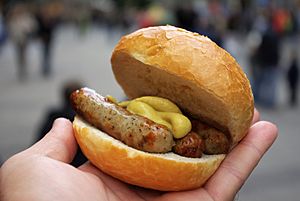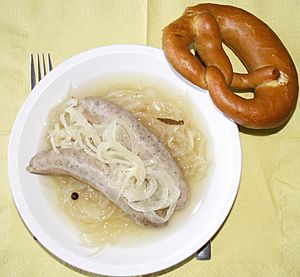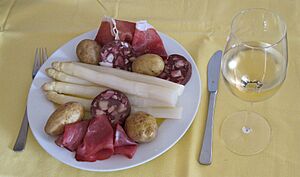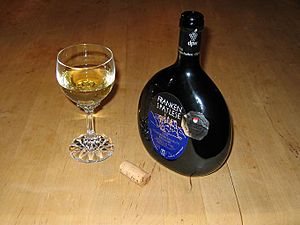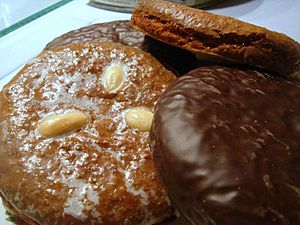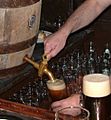Franconian cuisine facts for kids
Franconian cuisine is the name for all the special dishes from the Franconia region in Germany. It's a type of German cuisine and shares many similarities with food from Bavaria and Swabia. Even though most of Franconia is now part of Bavaria, its food has its own unique style.
Some Franconian foods are famous far beyond the region. These include Nürnberger Lebkuchen (a type of gingerbread), different kinds of Bratwurst sausages, and the special wines from Franconia. The region is also super famous for its beer. In fact, Upper Franconia has more breweries than anywhere else in the world!
Contents
Franconian Sausages
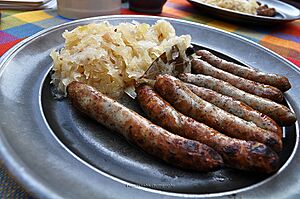
When people think of Franconian food, they often think of the famous "Nürnberger Bratwürste." These are small sausages made from pork. They can only be called "Nürnberger" if they come from the city of Nürnberg.
You usually eat them in a few ways:
- "Drei im Weggla": This means "three in a bun." You get three small sausages in a bread roll.
- As a meal: Six sausages are served with cabbage.
But there are many other types of bratwurst in Franconia!
- Around Ansbach, sausages are flavored with salt, pepper, and marjoram.
- In Western Mainfranken, the bratwurst is about as thick as your thumb and 12 centimeters long.
- The city of Hof has the "Hofer Bratwurst," which is smaller and leaner.
- In Kulmbach, the sausages are similar to Hof's but have more veal.
- The "Coburger Bratwurst" from Coburg is special because it's grilled over a pinecone fire. This gives it a unique smoky taste!
Most of these sausages are grilled or fried. They are often eaten with bread rolls, sauerkraut, or mustard. While kids often like ketchup with them, it's not the traditional way to eat them in Franconia.
Saure Zipfel
A different way to prepare sausages is to cook them in a special sour broth. This broth is made with vinegar, water, onion rings, carrots, salt, pepper, bay leaves, and juniper berries. The sausages simmer in this broth for about 15 to 20 minutes. This dish is called "Saure Zipfel" or "Blaue Zipfel," which means "sour" or "blue tips."
Raw Sausage Snack
For a mid-afternoon snack, called "Brotzeit" in Bavaria, people sometimes spread raw sausage meat on peasant bread. They add diced onions, salt, pepper, and paprika. In the countryside, this is sometimes called "Tartarbread," but it's not the same as real tartar, which is made from raw beef.
Other Sausage Dishes

Another popular Franconian "Brotzeit" dish is "Pressack mit Musik." This is a type of Head cheese served with onions. The "music" part is a funny way to say that onions can make you gassy! Other common sausages include Blutwurst, Bierwurst, and Leberkäse.
Franconian Fish: Carp

In the areas around Forchheim and Bad Windsheim, the mirror carp is a local fish. It's often cut in half lengthwise and baked. Sometimes, it's served "blue," which means it's cooked in vinegar or beer broth. The baked roe (fish eggs) of the carp is a special treat called "Ingreisch."
If you want to try these carp dishes, it's best to order them ahead of time at restaurants. The best time to eat fresh local carp is in early autumn, from September to November. After November, carp is often brought in from other countries and isn't as fresh.
Meat Dishes
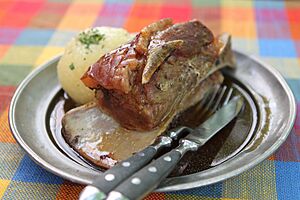
Like in many parts of Germany, Franconia has lots of meat dishes, especially with pork.
Schäufele
A very famous dish is baked pork shoulder, called "Schäufele." This name comes from the word for "shovel," because of the shape of the shoulder blade. It's known for its crispy rind.
Pork Roast
Another popular dish is pork roast with a crispy crust, served with potato dumplings. In Franconia, this is often eaten with red cabbage, savoy cabbage, or green beans.
Franconian Sauerbraten
The "fränkische Sauerbraten" is a special marinated roast beef. Unlike other versions, it doesn't use raisins. Instead, the sauce is thickened with soaked and slightly sweet ginger bread. This gives the dish its unique flavor, often served with red cabbage and sometimes lingonberry compote.
Schlachtschüssel
The "Schweinfurter Schlachtschüssel" is a traditional meal where cooked pork meat is served with sauerkraut, fresh bread, and ground horseradish on large wooden plates. People usually drink Franconian wine with it. At the end, guests often get some liver and blood sausage to take home.
Baked Blood
"Schwaaß," or baked blood, is still a popular traditional dish, especially near Hof. The blood of a slaughtered animal is collected and baked with diced bacon, onion, stale bread, marjoram, and salt. It's served with sauerkraut and potatoes.
Side Dishes
In Franconia, it's common to eat mixed salad and Klöße (dumplings) with any roast meat.
Klöße (Dumplings)
- Rohe Klöße: These "raw" dumplings are made from grated raw potato and filled with small pieces of stale bread. If there are any left over from a Sunday roast, they are often sliced and fried in a pan.
- Wickelklöße: These are made from potato dough that's rolled out, spread with melted butter, sprinkled with breadcrumbs, then rolled up and sliced. They are a specialty from Lower Franconia.
- Semmelklöße: These dumplings are made from mashed dry rolls soaked in milk and then cooked.
Sometimes, broad noodles (called Bandnudeln) are served with roasts instead of dumplings.
Vegetables
Vegetables are almost always side dishes in Franconia, rarely the main course. Common ones include sauerkraut, white cabbage, red cabbage, savoy cabbage, Kohlrabi, and carrots.
Salsify has been grown in Franconia since the 1600s. In winter, it's served in a cream sauce with ham and potatoes. In summer, asparagus from north of Nürnberg is used instead of salsify. Asparagus is also used in salads or eaten with bratwurst.
Horseradish
A special side dish or condiment is horseradish, called "Kren" in Bavaria. It's grown mainly around Erlangen, Forchheim, Höchstadt an der Aisch, and Baiersdorf. It's often used in the sauce served with Tafelspitz (boiled beef).
Soups and Salads
Soups
Typical Franconian soups include bread soup, semolina dumpling soup (Griesklöschensuppe), pancake soup (Flädlasuppe), and liver dumpling soup (Leberknödelsuppe).
Salads

Salads are usually served with a main dish. Popular ones are Franconian potato salad (made with Broth), mixed salad, or Coleslaw (Krautsalat). For a "Brotzeit" snack, Wurstsalat (sausage salad) is common.
Drinks
Franconia is home to about 270 breweries, many of them small. In summer, many breweries open their "cellars" where you can enjoy a snack with a liter of beer (a "Maß") or a half-liter (a "Seidel"). Upper Franconia has the most breweries in the world! A special beer from Bamberg is Smoked beer (Rauchbier). The main types of beer in Franconia are dunkel (dark beer) and pale lager (light beer).
The city of Kulmbach is sometimes called the "secret capital of beer." Bamberg has 12 breweries for only 70,000 people, making it "Franconia's beer city."
Franconian Wine
Wine is very popular in Lower Franconia, especially around the River Main. Franconia is a famous German wine region. Its wines are often bottled in unique, round "Bocksbeutel" bottles. The region is known for its white wines like Silvaner, Bacchus, and Riesling, and the dry red wine Domina.
During grape harvesting, you can also try Federweisser. This is an alcoholic drink made from grape juice that is still fermenting. It usually has about 4% alcohol.
Spirits
Franconian spirits are often fruit brandies (Obstbrände or Geist) or liqueurs. They are made from fruits like apples, plums, pears, or cherries.
Bread
Franconian bread comes in many types, from white wheat bread to dark brown rye bread. The typical "Fränkisches Landbrot" is a "mixed bread" with both wheat and rye flour. It usually has a high percentage of rye (about 80%) and special spices. It can be long (Kipf) or round (Laib) and usually weighs between 1 and 4.5 kilograms. Pretzels and bread rolls are also common.
Zwiebelkuchen
Franconian Zwiebelkuchen, which means "onion cake," is a savory pie. It's made with steamed onions, diced bacon, cream, and caraway seeds on a yeast dough base.
Lebkuchen (Gingerbread)
Ginger bread like Nürnberger Lebkuchen is one of the most famous Franconian treats. In the Middle Ages, Nürnberg was a big trading center for exotic spices. There were also many beekeepers nearby who supplied honey. These two things helped start the long tradition of gingerbread making in the city.
From late August until winter, these small biscuits are sold with "Christkindlesmarkt-Glühwein" (a special mulled wine with blueberries). Today, most Lebkuchen are made in factories, but a few small companies still make them by hand.
Around Christmas, many bakeries make their own Lebkuchen and other Christmas cookies. The most famous type is the "Elisenlebkuchen," which is often rectangular (most traditional ones are round). High-quality Lebkuchen must be made with wafers.
Küchla (Little Cakes)
"Küchla" or "Küchle" (meaning "little cakes") are a popular sweet pastry in Franconia. They are made from yeast dough, fried in a pan, and often prepared for special events.
There are different shapes: rectangular, square, or round. The round ones are most common and are called "Knieküchla," or "knee cakes." This name comes from the old way of making them. Bakers would stretch the dough over their knee to get the thin, see-through center. Today, they might use the back of their hand or a special tool. The middle of the round pastry is very thin, and the edge is puffy, tasting a bit like a doughnut. After frying, they are usually served with powdered confectioner's sugar.
Rectangular Küchle, also called "Striezel," puff up like a cushion when fried. They have a thin, flat golden-brown bottom and a thicker, cushion-like top. If the dough tears while being stretched, the pastry won't puff up and will stay flat. These misshapen ones are called "Dutschen."
Schneeballen (Snowballs)
Schneeballen ("snowballs") are a type of shortcrust pastry. They are especially popular in the town of Rothenburg ob der Tauber. Their name comes from their round, ball-like shape, about eight to ten centimeters wide. They are traditionally decorated with confectioner's sugar.
Images for kids
See also
 In Spanish: Gastronomía de Franconia para niños
In Spanish: Gastronomía de Franconia para niños


